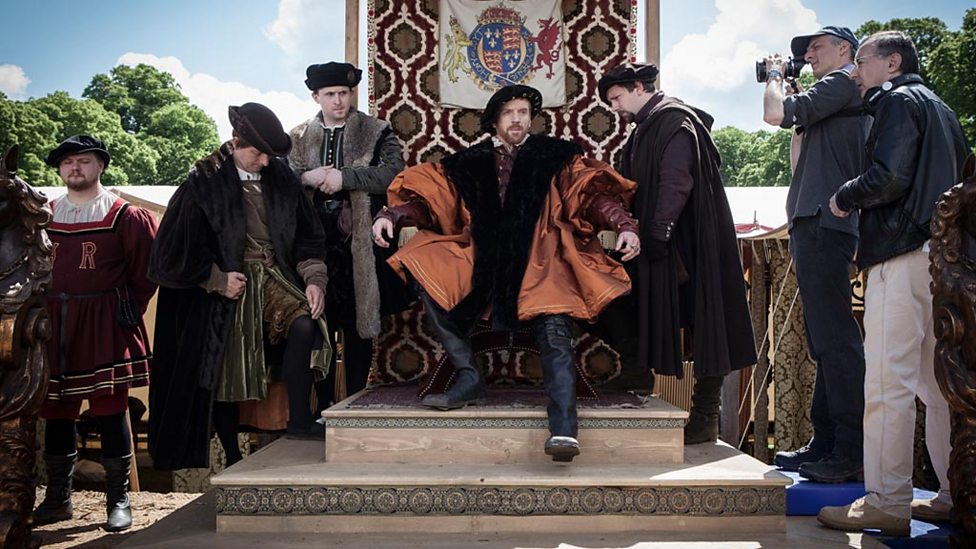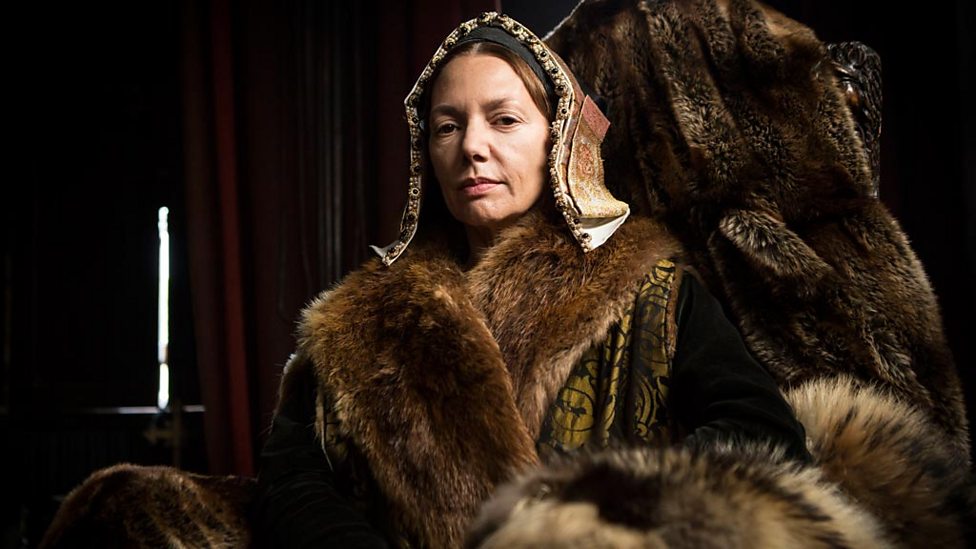In the week that the BBC launches its flagship Tudor television drama, Wolf Hall, I search the Deceased Online database for 16th century records and find one of Henry VIII's six wives.
 |
| Emmy-winner Damian Lewis, as King Henry VIII, being filmed for Wolf Hall (BBC) |
Inspired by the major new BBC Two (Masterpiece on
PBS) adaptation of Hilary Mantel’s Booker Prize-winning
novels
Wolf Hall and
Bring Up The Bodies, I have been in a Tudor mood this week. I finished reading the first of the two novels last month and was excited to see whether the television adaptation would capture the sense of humanity, period and place that the author described so vividly in her writing.
Mantel worked closely with director, Peter Kosminsky, during filming and has given drama her seal of approval, saying,
"My expectations were high and have been
exceeded: in the concision and coherence of the storytelling, in the
originality of the interpretations, in the break from the romantic
clichés of the genre, in the wit and style and heart. Mark Rylance gives a mesmeric performance as Cromwell, its effect building through the series."
 |
| Olivier award winner Mark Rylance as Thomas Cromwell in Wolf Hall (BBC) |
Mark Rylance, famed for bring the first Artistic Director of London's Globe Theatre, heads a quality cast of award-winning actors from stage and screen. Rylance's intimate, brooding portrayal of Thomas Cromwell, the son of a London blacksmith who became King Henry VIII's chief minister, draws the viewer into the narrative. Against the arc of Cromwell's personal story, we enjoy an insight into the politics of the Tudor Court, the drama of the King’s tempestuous relationship with Anne Boleyn and the
religious upheavals of the Protestant reformation.
 |
| Joanne Whalley plays Katherine of Aragon in the new BBC series (BBC) |
In the first episode (shown in the UK on 21 January 2015) viewers saw Katherine of Aragon question
ed
before the Legatine Court of Blackfriars, humiliatingly, about her virginity with regards to her first marriage to Henry's brother, Arthur. Katherine has only a minor role in Wolf Hall. She fades from prominence as Thomas Cromwell rises, but for the early part of Henry's reign she was a hugely popular Queen with the nation. Well-known for her piety and family connections to Europe's most powerful monarchs, Katherine should have been given a grand funeral attended by the grandest of nobles and royalty. Instead she was exiled far from Court. It was Cromwell's machinations that led to the Parliamentary Bill acknowledging Henry rather than
the Pope as head of the Church of England. As a result of this, Henry was able to grant his own divorce from his first wife.
 |
| The burial place of Katharine of Aragon at Peterborough Cathedral |
On Friday 7th January 1536, Katherine of Aragon (then
referred to as the ‘Princess Dowager’) died in Kimbolton Castle at the age of 49. The remarried King did not attend her funeral in Peterborough
Cathedral on 29th January. The Cathedral's burial records, including that of Henry's first Queen, can be explored online in the
Deceased Online database. The screenshot
below shows the search result for Katherine's entry.
Unlike her successor, Anne Boleyn, at least Katherine was allowed to die a natural death. As we shall see in fortcoming episodes of Woldf Hall, Anne's fate was far worse. Interestingly, Mark Shernick's
The Curiosity Shop blog has discovered that both Prince William and his wife, Kate (nee Middleton), share an ancestor in Anne Boleyn's niece and former attendant,
Catherine Carey, Lady Knollys
(1523 - 1586), who witnessed her aunt's beheading at the Tower of London
on May 19, 1536.

Surprisingly enough, this is not the only Tudor queen in the
database. As I revealed in
my
Peterborough Cathedral post,
the Cambridgeshire Cathedral has more royal connections, believed also to be the original
burial place of Mary, Queen of Scots.
I shall be watching Wolf Hall with interest over the next few weeks and checking back with the database to see whether I can identify the burial places of some of the minor characters in the series.
 |
Founded early in the 13th century by the Countess of Salisbury as a
nunnery of the Augustinian order, the exterior of Lacock Abbey is used to
represent Wolf Hall, the Seymour family seat. (BBC/National Trust)
We would very much like to hear from anyone who has managed to trace their ancestry back to the period of Henry VIII's reign: 1509-1547. Have you discovered where you ancestors were buried, or do you have connections to the the throne? Do let us know this and your thoughts on the new BBC drama in the Comments Box below, and on our Facebook and Twitter pages!
|




Comments
Post a Comment